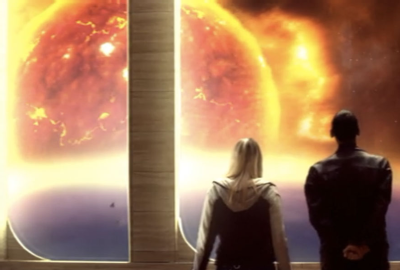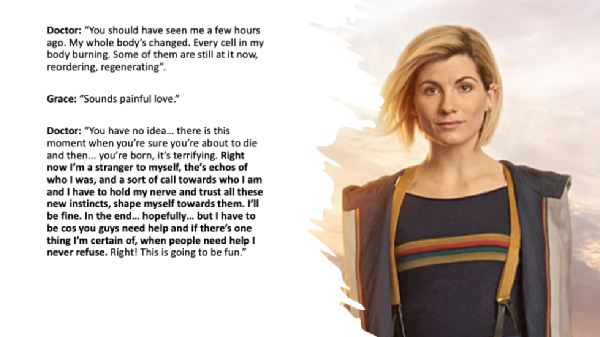Guest post: What can't you teach with Doctor Who?
Today Cosmic Stories hosts a guest post from Professor Jan J Eldridge, Head of the Department of Physics at the University of Auckland, and long term scientific collaborator in the study of distant stellar populations. To celebrate the anniversary of Doctor Who, Jan presented a talk at the Doctor Who 60th Anniversary Symposium at the University of Queensland, Australia, in November 2023, and this blog entry is based on that talk:
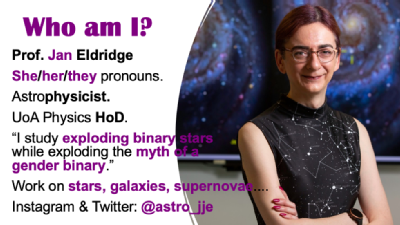 First, I’ll introduce myself. I’m Jan Eldridge, a professor, and head of department at the University of Auckland and I normally study exploding binary stars while exploding the myth of a gender binary. 😊
First, I’ll introduce myself. I’m Jan Eldridge, a professor, and head of department at the University of Auckland and I normally study exploding binary stars while exploding the myth of a gender binary. 😊
Second, I thought I’d point out I have met a few Doctors, as the image below shows.
I’ve used Doctor Who so much in educating students in physics, I wanted to share my ideas. I began with a series of lectures entitled “The Science of Sci-fi…” which explored topics ranging from spaceflight to gender with a variety of SF examples.
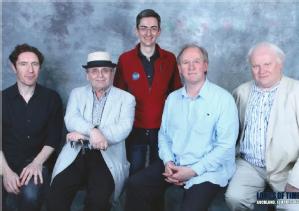
So… while I’ve ended up using Doctor Who for educational purposes, it’s only recently that I’ve really thought deeply about why this is possible.
We have to remember that Doctor Who was designed primarily as entertainment, but a small part of the program’s goal was to educate viewers too. This educational mission does make the show different to most other science fiction shows and makes it easier to find ways to demonstrate Doctor Who as an educational resource. Especially now the shows are becoming more available online (at least in the UK…).
The clearest example, of course, comes from time travel. A lot of Doctor Who is set in the past! Care needs to be taken with some episodes because while the story was set in the present or near future, that is now also in the past and viewers have to differentiate which is “real” history and which isn’t. In other words, these stories give a window into how people imagined their present and future, rather than necessary reflecting reality.
But of course, episodes featuring famous figures such as Rosa Parks and Vincent van Gogh (visited by the Thirteenth and Eleventh Doctors respectively) are prime examples of how important historical figures and different periods of history can be brought to life, to teach their stories to a new audience. I used to ignore these as I always like space fiction, but they are an interesting way to show people how things used to be - and this is now true even of stories not originally intended as historical episodes.
A real complication, however, is how to discuss the way in which technology has developed, as a lot of what we’re using today is shown in earlier Doctor Who as futuristic tech. It can be hard for young people to appreciate how bizarre and modern such devices might appear to the original audience... although I’m still waiting for my own K-9.
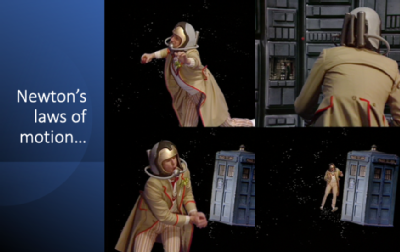 But I’d like to show you a few more educational examples I’ve used myself.
But I’d like to show you a few more educational examples I’ve used myself.
A really clear example of using Doctor Who to teach basic physics is from “Four to Doomsday”. Here the Fifth Doctor is stuck outside a starship and the Tardis. He reaches the Tardis by using a cricket ball he happens to have in his pocket. This is a nice demonstration of Newton’s 3rd law: to every action there is an equal and opposite reaction. When you throw the ball it flies off but you go in the opposite direction. But what is even better is that the ball bounces off the other spaceship exchanging momentum with it, and so the Doctor really speeds off to the Tardis when he catches it on its return. I have set an exam question on this, asking students how they’d get back if they were stuck outside their spaceship.
In my research career, I study how stars live and die, and it’s great that in Doctor Who gives me a rich source of examples for this too.
Remember that Time Lord technology was based on a black hole, formed in a supernova and harnessed by Rassilon to become the Eye of Harmony.
I also like that in the new series they talk about how the Sun will become a red giant one day, and destroy the Earth (although this isn’t certain) with the Ninth Doctor and Rose actually witnessing this event. And of course, the Tenth Doctor got to talk to Rose in a parallel dimension by using a supernova as an energy source – as he said: “burning up a sun, just to say goodbye”
 To continue on with astrophysics, a really neat thing to look at is exoplanets: planets around other stars. Of course, a lot of other planets look a lot like Earth… or gravel pits… I’m not sure why that should be. 😉 But one interesting thing is the entire classic series was broadcast before we found planets around other stars. Since the first discovery in 1992, we now know of over 5500 planets, and only a handful are like Earth (although even these are unlikely to be inhabited worlds).
To continue on with astrophysics, a really neat thing to look at is exoplanets: planets around other stars. Of course, a lot of other planets look a lot like Earth… or gravel pits… I’m not sure why that should be. 😉 But one interesting thing is the entire classic series was broadcast before we found planets around other stars. Since the first discovery in 1992, we now know of over 5500 planets, and only a handful are like Earth (although even these are unlikely to be inhabited worlds).
This made me wonder if there is a difference between classic and new Who as to the type of planets the Doctor visits? The answer if you look by episode number is surprising as the image from my study in Harmes and Orthia's Doctor Who and Science (2021) shows. The Doctor spends more time on Earth than anywhere else! And even more so in the new series! This is a bit surprising! But of course, this is because audiences need to be able to relate to what they see. We can also use lots more time travel to go to Earth over all of past and future history.
Anyway, it’s important to note that Doctor Who also has “weird” planets. Two examples are Krop Tor from the "Impossible Planet"/"The Satan Pit" (visited by the Tenth Doctor) and Voga from the "Revenge of the Cybermen" (featuring the Fourth Doctor).
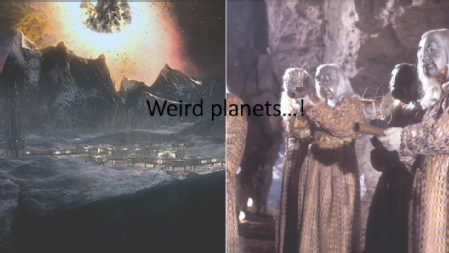
The first is a planet around a black hole - described in the episode title and dialogue as The Impossible Planet. Surprisingly this might not be as bizarre as we expect. We know of planets around other types of dead stars, neutron stars, and might detect black hole planets in future. In fact the first planets were found around a neutron star back in 1992.
As for Voga, it is a planet made mostly of gold. This might not be so impossible… we have detected that when those dead stars, neutron stars, merge together they produce about a Jupiter masses worth of gold. Again, future observations might reveal such planets, although probably not in our solar system.
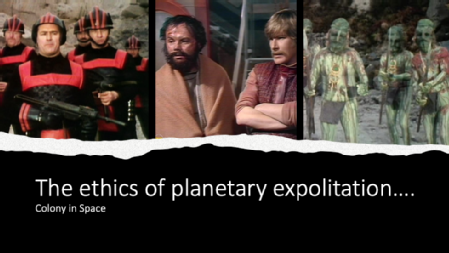 Another way to look at Doctor Who’s planets is their relevance to today’s very near future. Currently near-space exploration and exploitation is rapidly increasing, and it is only a matter of time until we might see commercial missions to asteroids and other planets.
Another way to look at Doctor Who’s planets is their relevance to today’s very near future. Currently near-space exploration and exploitation is rapidly increasing, and it is only a matter of time until we might see commercial missions to asteroids and other planets.
If, in the next century, these become crewed missions, then we may one day have a similar situation to the story “Colony in Space”, where there is a tension between a mining corporation out for profit, colonists who want a place to live and any indigenous life (although it’s unlikely to be humanoid!). Unlike Uxorious, we will not have the Third Doctor to arbitrate. But if we do discover some form of life on Mars… should we go there? Or would the search for profit and new living space for humans take precedence?
I’m not equipped to answer that question. I don’t think anyone is, but it is amongst the things we need to think about.
Finally, one recent thing I’ve been able to use Doctor Who for is talking about the complexity of sex and gender. I always talk about how wonderful and complex the Universe is but it turns out people are too. And so is talking about Time Lords and their regeneration when they change sex and gender.
This opens opportunities to think about the lived experience of transgender people. While I like the quip "Time Lady, thank you. Some of us can afford the upgrade!" from the Mistress when she was adressed as a Time Lord in "The Witch's Familiar", it’s interesting to consider exactly what it’s like to have the memories and experience of being another sex (and gender) and how that changes how a person acts.
In Doctor Who they haven’t explored this in detail, but there is this quote from the Thirteenth Doctor: “Right now I’m a stranger to myself, there’s echos of who I was, and a sort of call towards who I am and I have to hold my nerve and trust all these new instincts, shape myself towards them. I’ll be fine. In the end… hopefully… but I have to be ‘cos you guys need help and if there’s one thing I’m certain of, when people need help I never refuse.”
I use this quotation whenever I’m giving a talk on trans people to help people appreciate what it’s like: a number of trans people have pointed out how apt this quote is. Of course having just watched the anniversary special "The Star Beast", where a transgender person and non-binary gender is a part of the story linem there are now even clearer examples to use in future.
So, whether you're teaching history, culture, technology, physics, astronomy or gender... or many other topics... there's an example to be found which can interest and engage students. Anyway I hope you found that interesting and have been inspired (if you’re an educator) to use Doctor Who examples in your teaching. The long history of Doctor Who provides plenty of thought experiments to explore. The best approach to take is always to think “how might this work?” rather than being negative “saying it’s all rubbish”. It’s really fun.
Editor's Note: My thanks to Jan for sharing her thoughts on this topic. If you are interested in sharing Jan's work on astrophysics, equity and science fiction, you can follow her on Instagram and Twitter at @astro_jje or BlueSky at @astro-jje.
All views expressed in this blog are those of the author and do not necessarily reflect those of the University of Warwick. Images are sourced from public domain websites online or from private collections and are used here for commentary and criticism under fair use provisions.

